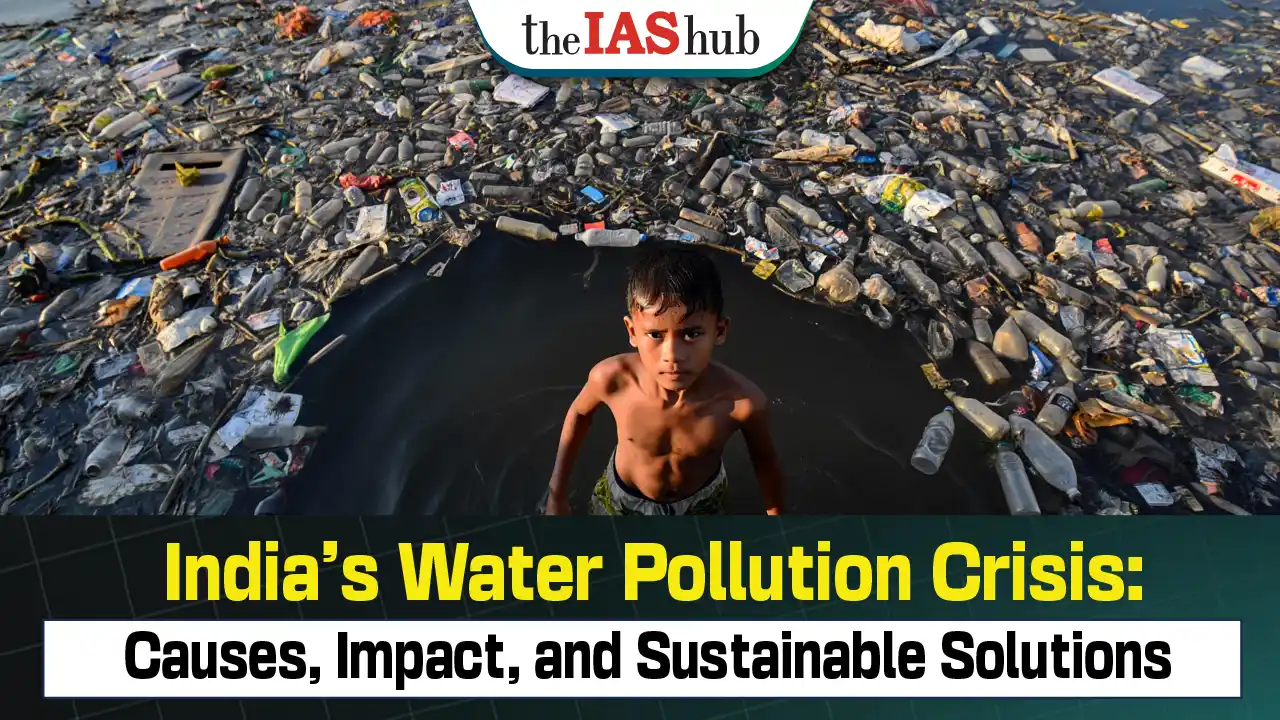India ranks 120 out of 122 in water quality, with 70% of freshwater contaminated. Explore causes of water pollution, its impacts, national & global measures, and innovative solutions like Arth Ganga, water-sensitive cities, and the One Water Approach.


As per NITI Aayog, overall, 70 percent of the freshwater sources in the country were found to be contaminated and India ranks 120 out of 122 countries in terms of water quality.
Water pollutants come from either point sources or dispersed sources. A point source is a pipe or channel, such as those used for discharge from an industrial facility or a city sewerage system.
A dispersed (or nonpoint) source is a very broad unconfined area from which a variety of pollutants enter the water body, such as the runoff from an agricultural area.
Impacts of Water Pollution: Destruction of biodiversity. Water pollution depletes aquatic ecosystems and triggers unbridled proliferation of phytoplankton in lakes — eutrophication. Contamination of the food chain

Arth Ganga serves as a pioneering model of river rejuvenation, merging economic growth with environmental sustainability. Through initiatives in pollution control, sustainable farming, biodiversity conservation, reforestation, and promoting cultural heritage, it embodies a holistic approach to transforming the life and landscape of the Ganga basin.
"Water-sensitive cities are not just about managing water, they are about creating vibrant, resilient, and livable urban spaces. They are cities that understand the value of water,embrace its presence and integrate it into every aspect of urban life."
News in Focus:
Water-sensitive cities in the Global South emphasize the need to address inequalities in access, functionality, and reuse of water resources for sustainable urban development.

|
Challenges Rapid Urbanization Pollution and Water Quality
|
Solutions
|
|
Urban Water Agenda 2030: An initiative launched by the United Nations Environment Programme (UNEP) to promote sustainable and equitable water management in urban areas, aligning with the Sustainable Development Goals (SDGs). |
Water-sensitive cities are essential for addressing the growing challenges of water scarcity, pollution, and climate change. By integrating sustainable water management practices, promoting community engagement, and adopting innovative technologies, cities can achieve resilience, improve quality of life, and ensure a sustainable future for all.
|
Extra Marks Fetching component by theIAShub Initiatives in India
|
"Adopting a 'One Water' approach means recognizing that water is a finite and interconnected resource, requiring us to manage it holistically and make decisions that consider the social, economic, and environmental dimensions of water sustainability."
Why is the “ONE WATER” approach better than conventional water management practices?

The One Water Approach holds immense potential for the future of water resource management. By integrating all water sources, promoting efficiency, resilience, and community engagement, it offers a pathway towards sustainable and holistic management, ensuring reliable water supplies for both human and ecological needs.


Refine your answer writing skills and elevate your UPSC preparation with personalized support and expert feedback.
Fill out the form to get started with the program or any other enquiries !








Are you dreaming of becoming an IAS officer? Then, IAShub can be your best guide. It is one of the Best IAS Coaching in Delhi. Many students who want to clear the UPSC exam join IAShub for learning. The institute gives both online and offline classes. Their teachers are experienced and helpful. They easily explain every topic. Students also get notes, tests, and tips to do well in the exam.
IAShub is in Delhi and is trusted by many UPSC students. It offers coaching for every part of the UPSC exam – Prelims, Mains, and Interview. The classes are simple and easy to understand. The teachers are experts and guide students in the right way. IAShub is also known for its helpful notes, test series, and answer-writing practice. IAShub is the best coaching in Delhi and also gives UPSC Online Classes. This helps students from any place in India to learn. The online classes are live and also recorded. So, students can watch them anytime. These classes cover the full UPSC syllabus.
Here are some important services provided by IAShub:
The UPSC Civil Services Exam has three parts:
This exam is tough, but with the right guidance, it becomes easy to manage. Students must study smart and stay regular.
IAShub supports students from the beginning to the end. It gives the right books, tests, and notes. The classes are easy to follow, and the teachers are always ready to help. Students get personal doubt sessions too. The test series and answer checking help students learn where they need to do better. Also, free study materials save time and money.
IAShub also guides students during the final stage – the interview. Experts take mock interviews and give useful tips. This full support makes IAShub one of the best IAS coaching in Delhi.